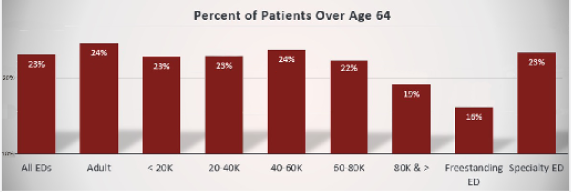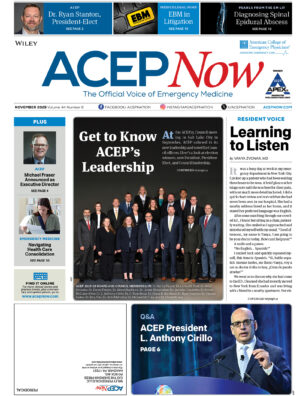Pandemic-related challenges continue to arise, and emergency physicians continue to manage the many implications. More forward planning will be a priority, as hospital and health care leaders look to emergency department leaders for guidance on planning. The performance of emergency departments in 2020 has been summarized by the Emergency Department Benchmarking Alliance (EDBA) in its annual survey report. One of the operational changes that occurred in the pandemic year was an ongoing decrease in young patients presenting to community emergency departments.
Explore This Issue
ACEP Now: Vol 41 – No 04 – April 2022Children have comprised a large mix of patients since the advent of emergency services. There has been some inconsistency in the definition of children, but in 2006, the leaders of emergency services agreed that the data definition of pediatrics would be individuals under the age of 18.1
Another source of data on ED visits is the Centers for Disease Control and Prevention (CDC) ED survey from the National Center for Health Statistics. That study has documented a decrease in ED visits by young persons. The CDC has used a different methodology and counts visits for patients under the age of 15 in all emergency departments including all children’s hospitals. In its survey, the percentage of ED patients under the age of 15 in 1982 was 25.4 percent, and in 2018, the visits were about 19.7 percent across all emergency departments.2
The EDBA data survey for 2020 allows a focus on community emergency departments, and in those facilities, the percentage of patients under age 18 is 13 percent. The data in Figure 1 display the trends in ED pediatric visit rates in community hospitals over the last 17 years. The last eight years in particular show decreased visit rates.

Figure 1: Percentage of ED patients seen in general service EDs who are under age 18, trended since 2003.
Visits by Kids Down to 13 Percent
One reason is the growing percentage of patients over the age of 64 who are being seen. The percentage of patients seen in general service emergency departments who are over age 64 has increased. The CDC data showed an 8.6 percent mix of patients over the age of 64 in 1992, the first year of its study. The number and percentage of senior persons are increasing in the general population, and in 2018, the CDC survey counted 17.9 percent of ED patients being over the age of 64.
The EDBA survey shows an even larger presence of senior patients in the ED population. The 2020 report data, displayed in Figure 2, count about 23 percent of ED visits that are persons over the age of 64. That data report excludes children’s hospitals. Therefore, some change in ED visits relate to the trends of an aging American population.
What Other Factors May Be Contributing to the Decrease in ED Visits by Children?
There are increasing pathways to unscheduled care for children and their parents. That includes expanded hours for pediatricians, the larger presence of urgent care centers in many metropolitan areas and the emerging presence of telehealth.
The role of emergency physicians has dramatically changed in response to the COVID-19 pandemic, and trends suggest emergency departments will see older, higher-acuity patients with more complex medical needs.5 The emergency department remains the portal for all patients, and general service emergency departments must be prepared for persons of any age. Even if the inpatient areas of the hospital do not care for children, the emergency department must provide initial care for all who will either be admitted or transferred. Recent publications point to the need for all emergency departments to be better prepared for ill or injured children and include access to preparedness materials.3,4
Thirteen percent of children present to community emergency departments these days. The relative infrequency of pediatric ED patients must not change the need to be prepared to care for them, including the equipment, processes, and training available in general service emergency departments.
References
- Welch S, Augustine J, Camargo CA Jr, et al. Emergency department performance measures and benchmarking summit. Acad Emerg Med. 2006;13(10):1074-1080.
- Cairns C, Kang K, Santo L. National Hospital Ambulatory Medical Care Survey: 2018 emergency department summary tables. Centers for Disease Control and Prevention.
- Newgard C, Lin A, Goldhaber-Fiebert JD, et al. Association of emergency department pediatric readiness with mortality to 1 year among injured children treated at trauma centers [published online ahead of print February 2, 2022]. JAMA Surg.
- Remick K, Gausche-Hill M, Joseph MM, et al. Pediatric readiness in the emergency department. J Emerg Nurs. 2019;45(1):e3-e18.
- Augustine JJ. Pre-COVID ED trends suggest more challenges lie ahead. ACEP Now. 2020;39(11):10.
Pages: 1 2 | Multi-Page




No Responses to “Is An Aging Population Aging Out Younger Patients?”